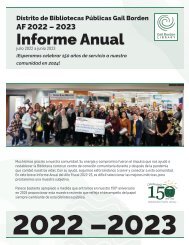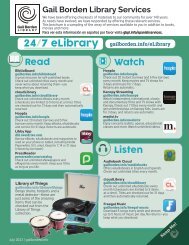September October Newsletter 2020
Create successful ePaper yourself
Turn your PDF publications into a flip-book with our unique Google optimized e-Paper software.
<strong>September</strong>-<strong>October</strong><br />
City of Elgin<br />
<strong>2020</strong> <strong>Newsletter</strong><br />
Save Water.<br />
Save Money.<br />
Don’t Let Your Money Go<br />
Down the Drain<br />
Water infrastructure needs to be maintained by both your utility (the City’s<br />
water department) and you. The City can check for leaks in pipes on the way<br />
to your home, and you can check for leaks in your home. Both actions<br />
prevent water waste and improve the reliability of your water supply.<br />
Do you feel like you have a high water bill? Most high bills are due to leaks.<br />
The best method for determining whether or not a leak exists is to take<br />
actual water meter readings. This method checks the entire internal<br />
plumbing for water leaks.<br />
Take a water meter reading just before going to bed, or when no one will<br />
use any water for several hours. Take another meter reading in the morning<br />
before any water is used, or after a few hours of non-usage. In theory, the<br />
two readings should be the same. If they are not, and you cannot account<br />
for use by a humidifier, ice cube maker, toilet flush or water softener, you<br />
have a leak and further investigation is recommended.<br />
Conserve Water at Home<br />
Lawn Care<br />
More than 50% of commercial and residential irrigation<br />
water use goes to waste due to overwatering,<br />
evaporation and runoff. Consider watering your lawn no<br />
more than twice a week before 10 a.m. or after 6 p.m.<br />
Indoors<br />
Use WaterSense® labeled toilets, sink<br />
faucets and showerheads. They are<br />
inexpensive, easy to install and can<br />
save hundreds of gallons per month.<br />
Check the Consortium for Energy<br />
Effciency website (cee1.org) to<br />
compare water use between models<br />
of appliances, like a washing<br />
machine. Energy Star models can save<br />
up to 20 gallons of water per load.<br />
When waiting for hot water, collect<br />
running water and use it to water<br />
plants.<br />
Match the water level of laundry<br />
machine to the size of the load.<br />
Wash dark clothes in cold water,<br />
saving water and energy and helping<br />
clothes retain their color.<br />
Reuse your towels.<br />
Take a shorter shower (try for under 5<br />
minutes). And take a short shower<br />
over a bath—a full bathtub requires up<br />
to 70 gallons of water!<br />
Teach children to turn off faucets<br />
tightly after each use.<br />
Designate one glass for drinking<br />
water each day, or refill a water bottle.<br />
Don’t thaw food with running water,<br />
use the refrigerator.<br />
Find more ways to conserve water and lower your water bill at<br />
wateruseitwisely.com.<br />
The Most Common Water Waster:<br />
Toilet Leaks<br />
The toilet is the most common water wasters. To determine if your<br />
toilet is leaking, look at the toilet bowl after the tank has stopped<br />
filling. If water is still running into the bowl, or if water can be heard<br />
running, your toilet is leaking.<br />
Most toilet leaks occur at the overflow pipe or at the plunger ball<br />
inside the tank. To locate a toilet leak, take the tank lid off and flush.<br />
The water level should come up to about a half inch or so below the<br />
overflow pipe. Adjust the float level control screw, if necessary, so the<br />
valve shuts off the water at that level. If the valve itself is leaking, you<br />
may need a plumber to fix it.<br />
Although water may not be seen or heard running, your toilet may<br />
have a silent leak. To test for a silent leak, drop a little food coloring<br />
into the tank. Do not flush. Wait for about 10 minutes. If the food<br />
coloring appears in the toilet bowl, your toilet has a silent leak.<br />
It is probably located in or around the plunger ball or flapper valve at<br />
the bottom of the tank. These leaks are easy to fix with inexpensive<br />
parts from your local hardware or home store.<br />
If no leaks were found, the next step would be a thorough inspection<br />
of your pipes, lines, connections and valves under your home or in<br />
your basement. Your hot water tank could have a hole rusted in the<br />
bottom or the drain valve may be leaking. You may also check faucets,<br />
showerheads, appliances and outside taps for leaking water.<br />
By following these simple steps, you should be successful in finding<br />
accurate results that could save you money.<br />
Flush<br />
Valve<br />
Fill<br />
Valve<br />
There are two main toilet tank parts: The toilet flush valve, which lets<br />
water gush into the bowl during the flush, and the fill valve, which lets<br />
water refill the tank after the flush. When a toilet runs constantly or<br />
intermittently, one of these valves is usually at fault. The three most<br />
common toilet tank part setups are shown above.<br />
GAILBORDEN.INFO D<br />
CITYOFELGIN.ORG | 311 (OR 847-931-6001)<br />
D


















